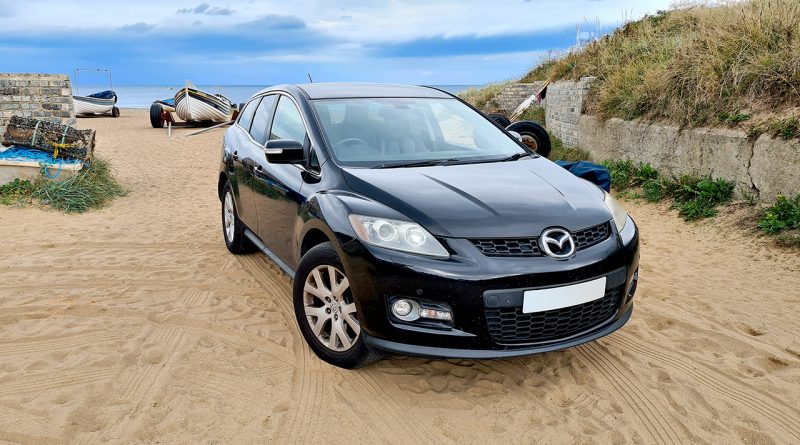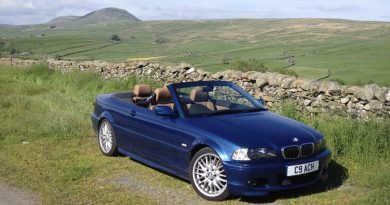Cars of the Northern Group: Andrew’s Mazda CX-7
As anyone who knows me will already know, you’re never short of a Mazda at mine. Chances are you’ve seen our burgundy MX-5 at an event, or our recently replaced CX-3. The less said about the MX-3s the better, for now at least.
However, recent fleet changes — the MX-5 has been resprayed and stored away, waiting for our daughter to take custody once she’s passed her test at last and got a house with a garage — along with changes to both our work schedules meant I could do with a replacement vehicle. The MX-5 never really was suitable for 150-mile round trips, and somewhat drowned out navigation directions from my phone anyway.
I had only a handful of requirements for the new machine:
- Be large enough to carry bulky equipment
- With a future project in mind, towing ability would be nice
- It mustn’t be boring to drive or slow, but still have comfort for long journeys
- No more than £3,000
- Not diesel
- Mazda
As it turned out, that narrowed the field down to… well, one: Mazda’s short-lived CX-7, in turbocharged petrol form. Based on the same platform as the Ford Focus Mk2 and the first generation of Mazda 3, the CX-7 is essentially a C-segment crossover but exclusively used the powertrain and running gear from the hot Mazda 6 MPS “Mazdaspeed” saloon.
What that means is a turbocharged 2.3-litre, four-cylinder engine good for around 260hp, delivering power to the front and — as required — rear wheels through an “intelligent” all-wheel drive system. With Mazda’s traditionally slick gear shift action on the six-speed box and unnecessarily on-point driving dynamics, that checked off “not boring to drive or slow”.

It also guarantees rarity. I have this theory (on the basis of nothing) that Mazda really wanted out from under Ford’s ownership and made this thing to make it happen; while everyone else’s crossovers made money hand over fist, almost all of the CX-7’s good qualities were undone by a ludicrously high VED bracket which cost £750 the moment it hit the road and £415 each year thereafter (which is up to £615 now!).
Obviously nobody bought it – Mazda shifted something like 400 a year in the UK – so it was replaced with a dull 2.2-litre diesel, which was down almost 90hp and nobody bought that either. Ford subsequently got rid of Mazda, and Mazda started making all of its excellent SkyActiv cars.
While already rare originally, the CX-7 petrol has moved into endangered territory. According to sites like How Many Left, around half of the cars sold still remain, 14 years on. Many rotted from beneath — because people drive SUVs through the winter and never wash the road salt off underneath — while the relatively fragile engine, when not properly cared for or tuned too far, accounts for others. The petrol CX-7 routinely pops up as a car you just… shouldn’t buy… but I love an underdog.
That made finding a car actually quite a challenge. It took several months, and friends in far-flung places going to poke about underneath examples, before I found a car that was not mostly made of Twiglets underneath and not coming up on or past danger mileage; 100,000 miles is a fabled land of myth for most CX-7s (and MPS3 and MPS6 models that share the engine). And also not with the nasty cream interior, which looks great in photographs but is dreadful in the scratchy flesh.

It was a private seller, on AutoTrader, happy to take shots of the underside and with only the slightest issue of being in Reading. However I took a chance on it, took a train down, shook hands on £2,000 for it and drove it right back up to Yorkshire the same day.
Of course I wasn’t expecting perfection, and I was planning on making it a little bit of a running restoration project, but the car had a few more foibles than I’d anticipated. Spinning up to over 4,000rpm — peak power hits at 5,000 — resulted in a Bond-esque black smokescreen, and it had a weird off-throttle offside lurch, along with some pretty underwhelming brakes.
A quick oil and filter change later, which apparently hadn’t been done in a while judging by the quantity and viscosity of what came out, cured the clouds, while an alignment check revealed that the wheels were pointing like hippo’s teeth and explained that shimmy. That also made for some exciting tyre wear patterns, flagged as advisory on the otherwise clean MOT.
Since then, the CX-7 has been something of a workhorse, moving ludicrously large items including helping my daughter move to a house that doesn’t have a garage — so the MX-5 is still in ours anyway — as well as on various jobs around the north. It’s been comfortable and reliable, and very much hilarious to drive. However some necessary jobs remain, and they’ll be covered in the next update.
What it is: Mazda CX-7 2.3 DISI Turbo
How much it cost: £2,000
Running costs to date: 25.7mpg, VED & insurance (~£900)
Costs since last update: MOT, oil/filter change, wheel alignment, rust spot removal & polish (~£400)




